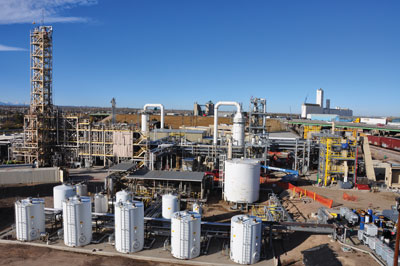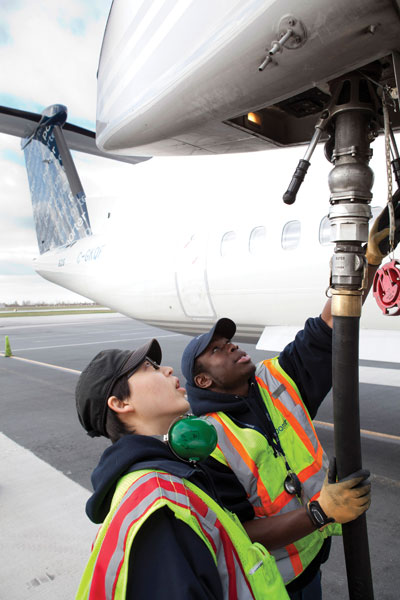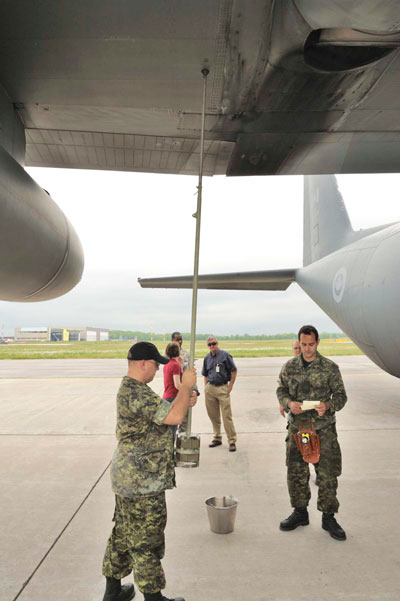
Features
Operations
Finding An Alternate Approach
The development of aviation biofuels is all the rage, and there’s plenty of hype out there as to how they’re going to revolutionize the skies.
July 10, 2012 By Brian Dunn
The development of aviation biofuels is all the rage, and there’s plenty of hype out there as to how they’re going to revolutionize the skies. But how viable is the hype and when will this groundbreaking technology reap rewards?
 |
|
| Rentech plans to convert about 1.1 million cubic metres per year of Crown timber into 85 million litres annually of RenJet low-carbon jet fuel under its Olympiad project in White River, Ont. The White River facility will look much like this plant in Commerce City, Colo.PHOTO: RentecH Inc.
|
The boldest pronouncement to date comes from China which expects to use 12 million metric tons of domestically produced aviation biofuel a year through its Petroleum & Chemical Corp. by 2020, or about 30 per cent of projected consumption by then. It claims to have the technology to make aviation biofuels from cooking oil and seaweed, but needs to reduce production costs, as biofuels, for far lacking a market, are more expensive to produce than regular jet fuel.
Boeing, meanwhile, has signed an agreement with Chinese plane maker Commercial Aircraft of China (COMAC) to collaborate on research into fuel-efficient technologies. As part of the agreement, the two aircraft makers will set up the Boeing-COMAC Aviation Energy Conservation and Emissions Reductions Technology Centre in Beijing. The jointly funded research centre will study ways to enhance commercial aviation’s fuel efficiency and reduce greenhouse-gas emissions.
A similar initiative has been launched between Air New Zealand, Qantas and Virgin Australia, who, along with Boeing and Airbus, as well as other main players from the biofuels and aeronautical industries, have partnered with oil major Caltex, to create a sustainable aviation roadmap.
In March, Boeing, Airbus and Embraer signed a memorandum of understanding “to work together on the development of drop-in, affordable aviation biofuels,” the aircraft manufacturers announced at an Air Transport Action Group meeting in Geneva. The companies said in a joint statement that they have “agreed to seek collaborative opportunities to speak in unity to government, biofuel producers and other key stakeholders to support, promote and accelerate the availability of sustainable new jet fuel sources.”
Bombardier is also actively engaged in several biofuels initiatives including an all-Canadian initiative involving Porter Airlines, Bombardier Aerospace, Pratt & Whitney Canada and the Green Aviation Research and Development Network. Bombardier also continues to be very active in the U.S.-based Commercial Aviation Alternative Fuels Initiative that the company has been involved with since its inception in 2006.
Making its mark
The aviation industry is coming under increased pressure to reduce its environmental footprint. Aviation fuels represent 12 per cent of the fuel consumption in transportation and jet fuel use is doubling every 10 years. The rush to find energy-efficient and economically viable ways to produce aviation biofuels is also being encouraged by the European Union’s new carbon-emission tax which it levies on airlines using EU airspace but which would be rewarded by using alternative jet fuels.
 |
|
| On April 17, Porter operated the first bio-fuel revenue flight in Canada, the successful conclusion to a test program launched in 2010. The airline flew a Bombardier Q400 from Billy Bishop Toronto City Airport to Ottawa using a 50/50 blend of biofuel and Jet A1 in one if its engines. PHOTO: bombardier
|
While the move has angered many airlines, especially those from the U.S. and China, it is hoped the ruling will give biofuels an added push to further develop a common alternative to conventional aviation fuel.
As noted, many of the world’s largest airlines, including Air Canada, are getting in on the act. In 2009, Air Canada announced it was entering into a memorandum of understanding with 14 other major airlines from the U.S., Mexico, Canada and Germany, to purchase 750 million gallons of renewable jet fuel and diesel derived from camelina by producer AltAir Fuels of Seattle. AltAir will use refining technology developed by UOP, a division of Honeywell, to convert camelina oil into a 100 per cent drop-in replacement for petroleum jet fuel. UOP’s refining technology has already produced biojet fuel for various test flights and U.S. military contracts.
But Air Canada’s commitment lags behind many of its competitors around the world. Lufthansa has already completed a six-month trial operating the world’s first biofuel-powered route as some 1,200 flights were completed between Hamburg and Frankfurt, reducing carbon dioxide (CO2) emissions by 1,471 metric tons. KLM also operated 200 biofuel flights last year and Hong Kong’s Cathay Pacific has announced plans to research a jungle plant for a food non-competitive biofuel. Cathay has also claimed that within 20 years, biofuels may cost half the price of traditional fuels.
“Thanks to the higher energy density of biofuel, it has been possible to reduce fuel consumption by more than one per cent,” according to Peter Schneckenleitner, Lufthansa’s head of political communication.
But there are some critics who claim biofuels are not actually that green. “Biofuel production is trashing rainforests, causing climate-changing emissions and making food prices spiral,” says biofuels campaigner Kenneth Richter of Friends of the Earth, the world’s largest environmental network with more than 5,000 activist groups and two million members worldwide. “Using them as aviation fuel would make matters even worse.”
One of the major worries concerns food availability and the side-effects of growing biofuel crops. Biofuels are fuels converted from processed biomass including vegetable oils and animal fats. Plantation of these crops may not only sacrifice croplands for food, causing food shortages, but carbon dioxide would also be released during deforestation and biofuel production
It all means that a biofuel-dominated aviation industry is decades away, at least. “It’s right that we research the potential of alternative biofuels like algae, but even if shown to be a climate-friendly option, its use is years in the making,” concedes Richter.
Lufthansa’s Schneckenleitner admits there is “a long and hard way to go” before biofuels become the major fuel in aviation. He adds that practical biofuel trials at Lufthansa will only be continued if more certified sustainable sources are available.
Schneckenleitner notes there are still a lot of challenges ahead; for example, the use of sustainable, certified biomass has to be secured, airport infrastructure for biofuel use has to be adapted and the whole supply chain and logistic processes has to be optimized, among other issues.
While Air Canada was the first domestic carrier to announce it was getting into the biofuels sweepstakes, on April 17, Porter operated the first bio-fuel revenue flight in Canada, the successful conclusion to a test program launched in 2010. The airline flew a Bombardier Q400 from Billy Bishop Toronto City Airport to Ottawa using a 50/50 blend of biofuel and Jet A1 in one if its engines.
The Q400 flew on the American Society for Testing and Materials (ASTM) D7566 bio-derived jet fuel, which was recently certified. A six-partner consortium, led by Targeted Growth Canada (TGC) of Saskatoon, demonstrated the viability of biofuel produced from camelina in a Porter Airlines Bombardier Q400 turboprop. Renewable fuel from camelina offers a real opportunity to reduce the environmental impact of commercial aviation by significantly reducing carbon lifecycle emissions, according to TGC.
The Q400 aircraft is equipped with standard Pratt & Whitney Canada PW150A engines. Sustainable Oils, LLC and Honeywell’s UOP all participated in the camelina biofuel test program on the aircraft along with TGC, Bombardier Aerospace, Porter Airlines and Pratt & Whitney Canada. TGC worked on crop optimization and growth, Sustainable Oils pre-refined the camelina oil and Honeywell’s UOP produced the hydro-treated renewable jet (HRJ) biofuel from the oils provided.
Growth potential
TGC appears to be one of the few Canadian companies developing aviation biofuels. Another is Rentech of White River, Ont., located about 300 kilometres northwest of Sault Ste. Marie. According to the Renewable Fuels Association of Canada, none of its members is in the game.
Rentech plans to convert about 1.1 million cubic metres per year of Crown timber into 85 million litres annually of RenJet low-carbon jet fuel under its Olympiad project in White River. It could be the largest renewable clean jet fuel program in the world, according to the Los Angeles-based company. The facility is currently scheduled to go online in 2016, a year behind schedule, as it looks for funding for the $500 million project. Rentech has applied for $200 million in funding from Ottawa’s Sustainable Development Technology Canada program.
Unlike other renewable jet fuel, such as fuel derived from animal fats and plant oil, Rentech’s technology is a second-generation gasification/F-T conversion process technology that involves cellulosic feedstock, derived from woody biomass. Rentech uses non-disruptive and sustainable biomass resources that do not compete with food or utilize agricultural land.
“We have just completed our first due diligence phase at our integrated bio-refinery plant in Commerce City, Colo., which is producing syngas from wood waste and then upgrading to transportation fuels. We hope to proceed to the second stage feasibility phase which we will find out in June,” explains Colin Campbell, Rentech’s vice-president of business development for Canada. “We are starting to make progress with a number of interested investors and as such, we are confident that a project of this magnitude will be funded.”
While WestJet has no immediate plans to use biofuels or conduct a biofuel-powered flight at this point in time, biofuels remain part of its future fuel supply strategy, according to company spokesperson Robert Palmer.
“Canada currently has all the key ingredients to produce sustainable aviation biofuels,” Palmer says. “For our part, WestJet continues to evaluate any viable opportunities that may be available to us. However, as a low-cost carrier, we want to ensure that we arrive at a cost-effective and truly sustainable solution.
“What is presently missing in the discussion on this issue is a Canadian policy framework to advance the use and development of aviation biofuels. Such a framework would add a key element of certainty, which is needed for any opportunity to be realized.”
Like WestJet, Air Transat is still in a monitoring phase on biofuels, but is “currently studying the feasibility of using them for its long-haul flights. Exchanges have been initiated with the companies Airbus and SkyNRG (a consortium that is actively developing a sustainable production chain for aviation biofuels) to look into potential solutions that would respond to criteria for production,” according to Transat’s Debbie Cabana.
“One of the key aspects of this approach is the need to find a local or regional source of supply that is compliant with the principles of sustainable development, including maintenance of land use for food production. In addition, we are facing supply difficulties, since all airlines obtain their fuel from the same source. For the use of biofuels to become possible, all of the air carriers must work together. This work is being done by the environment committee of the National Airlines Council of Canada, of which we are members.”
Clearly, there are some hurdles airlines have to overcome before biofuels take off. These include government regulations and incentives to develop the industry, lower costs, a reliable supply of biofuels and distribution channels at airports. But the fact remains, biofuels are indeed a key element in the ultimate greening of the skies – as so many aviation companies in Canada and abroad are starting to realize.
Royal Canadian Air Force gets in on Green Game
The Royal Canadian Air Force (RCAF) successfully flew a CC-130H Hercules aircraft using a semi-synthetic jet fuel, blended with plant-sourced oil, for the first time on May 23 at 8 Wing Trenton, Ont. Under the technical guidance and support of the Department of National Defence’s Quality Engineering Test Establishment (QETE), the demonstration flight-tested the efficacy of a blended jet fuel with 50 per cent F-34 and 50 per cent fuel derived from the camelina plant. “F-34 [also known as JP-8] is the jet fuel used by NATO countries, including Canada,” says QETE’s Pierre Poitras. “During this flight demonstration, we tested the suitability of an alternative jet fuel using camelina-derived fuel blended with F-34 as substitute or replacement for conventional aviation fuel. We’re happy with the results.” The biofuel demonstration flight started with a 24-hour leak check and was followed by almost two hours of flight on 424 (Transport) Squadron’s Legacy Hercules aircraft. According to 424 Squadron pilot Maj. Wayne Sippola, they flew the aircraft 100 miles to the North from 8 Wing Trenton, then South to Sandbanks in Prince Edward County before landing back to the base. In September and October 2011, the semi-synthetic jet fuel was tested at 8 Wing on an engine that is comparable to the Legacy Hercules aircraft (for example, the Rolls-Royce/Allison T-56-A-15). The test was successful, which led to the flight-testing that is needed for the certification of the camelina fuel blend specification. “This biojet fuel along with similar bio-crude materials, has great potential to become a sustainable and renewable alternative to conventional fuel, which would provide flexibility to the Canadian Forces with respect to fuel security,” says Poitras. “Our interoperability with NATO and U.S. allies is of prime importance to CF operations,” says Lieut.-Col. Geoffrey Carter from the Directorate of Fuel and Lubricants. “Since our allies are exploring the use of biojet fuel, we also want to ensure that when our countries work together, our equipment, handling processes, as well as the type of fuel that we use are interoperable,” he adds. Camelina sativa is an oil plant in the family Brassicaceae from the mustard family. It is a promising alternative to conventional fuel as it does not compete with the food chain simply because it is not part of any human or animal diet. A conventional jet fuel blended with plant-sourced fuel is better for the environment due to its potential for the reduction of greenhouse gases emissions. “Carbon emission from aircraft engines is a function of the concentration of aromatic hydrocarbons allowed in conventional jet fuel. Biojet fuel SPKs [synthetic paraffinic kerosenes] derived from camelina or carinata, does not contain any aromatic material, which basically reduces carbon emissions when blended with 50 per cent F-34, to meet the minimum aromatic concentration of the jet fuel specification” he says. – Lt.-Christopher Daniel, 8 Wing Public Affairs Officer |
